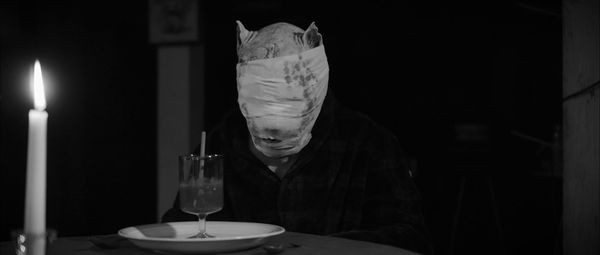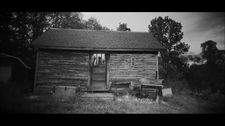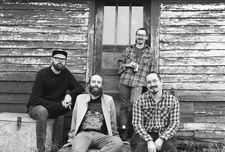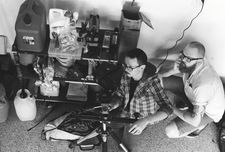 |
| Greywood's Plot |
One of the things that makes Frightfest great is its commitment to supporting new talent, and every year there’s one film in its line-up that has been made by complete beginners for about the same amount of money that it costs to buy a festival ticket. This year it’s Greywood’s Plot. I met up with director Josh Stifter to discuss it, and he had quite a story to tell.
“I had this idea, when I was a kid, that I wanted to make a movie where Daniel [Degnan], who plays Doug Greywood in the movie, turns me into a dog man,” he begins. “Me and the dude who plays Miles, Keith Radichel – me, Keith and Daniel have been friends since kindergarten. I've actually known Keith since I was 13 days old. Like, he was born 13 days after me. And we met like days later. So I, you know, as much as babies can meet, I've known him my literal entire life.
 |
| A mysterious cabin in the woods |
“So when I was growing up, I wanted to make movies, and I was making movies with my friends, short films and stuff like that. But these same friends, but you know, you get to a certain age, and you're like, ‘Well, I’ve got to make money, I’ve got to make a living.’ I started a family and had to provide for them so I went to school for animation, and got a job doing animation. I had a mortgage, I had two kids, and I turned 30. And just went, ‘Wow, there was like one thing on my bucket list for my whole life, and that was to make a feature film. That's the only thing I ever wanted to do, was to make a feature. And I turned 30 and hadn't done it. So I turned to my wife. And I'm like, ‘This year, I'm making a movie. I have to. I don't know what it's going to take, but we have to make the movie. So I call my friends. And for my 30th birthday, or 31st birthday, whatever it was, I told them, ‘Let's go make a movie. Let's just go into the woods and make something.’
“So I wrote out 40 note cards. That's one of the methods that filmmakers use to make film. You write out 40 note cards and do 40 scenes, and you can make a movie. And I was like, ‘Let's go in the woods and just see what we can do with this.’ No script, nothing. So we went out in the woods and started filming. The only concept I had was I wanted it to end with Daniel turning me into a spider man. At the time it was a spider man because I have terrible arachnophobia. And I'm like, ‘Well, I'm gonna make myself into the thing that scares me.’ So we went out the woods, tried filming and failed miserably.
“It was terrible the first time we went filming. We came back with a lot of beautiful shots, and a lot of those shots made it into the movie, but we just didn't have a story. We were improvising stuff that just felt really rambley. And it just wasn't working. So then I started to actually sit down and write the script. And as I was writing the script, that's when I got a call from El Rey network weekend, Robert Rodriguez.
 |
| A shadowy figure approaches |
“They asked me if I wanted to be on the show Rebel Without A Crew and make a movie for $7,000 in 14 days. So I wrote a script for that, and it turned into The Good Exorcist. And I went on this reality show and made that, and then that bucket list thing had been crossed off. I was like, ‘Oh, I made a feature film.’ And all of the pressure was off myself to get that done. Then we went to South by Southwest with that. And then in the spring, around the time the snow was melting in Minnesota, I was like, ‘You know what? I'm going to actually write this script. In fact, even on Rebel Without A Crew, as Daniel and I were finishing an exercise, I was like, ‘That was fun, but I think we’ve got to go finish Greywood’s. And he was like, ‘Yeah.’
“I came up with this concept based on the footage we had before and what we had filmed and what we had talked about during the filming. That's when I came up with this dog man concept and started to build more of what this movie actually was and find the emotion of what I wanted to say. And then the next fall, or the next summer, we went back out where the cabin was, and we filmed for another five days, or something like that. And then I filmed a lot of the stuff where I'm in my basement. It was just me in my basement by myself filming, or sometimes my wife would come down and help. My wife is there throughout the movie as well. She's the mail person who brings the tape at one point. She's one of the monsters in the woods. She's the voice on the TV. I would just be like ‘I need someone to do this,’ and she would be the one to do it.
“Over that next fall, we pulled the movie together, and then I was editing and then a bunch of stuff happened. As I was editing, I was like, ‘I have an idea for another scene. Let's do this,’ and I filmed in the winter. That's why you see every season through that movie. Because it's black and white, I can kind of get away with it. But at one point, they're walking through the woods, and the leaves are all green, and then a second later, they're all yellow, and then the next second, it's snowing. Like it just goes everywhere in the span of one movie. And I thought that was fun. That gives it the sort of Wizard Of Oz dreamlike insanity that I really wanted to hit.
 |
| We don't talk anymore |
“We just sort of came together, the four of us – me, Daniel, Keith and [Nathan] Strauss, whp plays the fly man in the movie. He wasn't originally supposed to be there but on my birthday, the first time I filmed, when Daniel showed up, Strauss just walked out of the car. He was like, ‘Hey, I just decided to come along.’ So it went from three of us going to film a movie to four of us, just because Strauss was so gung ho and none of them had ever filmed anything before.
“I work on film every once in a while, and I get on film shoots and stuff, so I understand how it works: three point lighting, how to record dialogue, all of that stuff. They had no idea and by the end, it was crazy, they were like my crew. I could tell them ‘We're going to set up three point lighting I need that one there and this one close. Let's give it a nice low angle on this lighting to give it that creepy vibe,’ and they would know how to do that. One of the things I'd say is ‘I need guts!’ so Daniel knew that that meant he had to go make bread dough, because all the guts in the movie are bread dough.”
It was a constant learning experience for all of them, he explains.
“When we first went into it, even the concept of how to connect sequences in a feature is so different than a short film, line animation or anything, so as we went through it I was learning the technical way of making things flow and making the movie work as a whole. We had kind of learned on the reality show but the way that movie came together was so just like fly by the seat of your pants. With this one we were able to really think about it and figure it out.
 |
| Who is that masked man? |
“It's so easy to get lost in the moment and take too much footage or like overdo things. I did all the sound design myself and on the good Exorcist I struggled with the sound design, both recording it and the post production side of mixing and mastering. On Greywood’s, I really wanted to make sure that the sound wasn't distracting. I spent hours and hours watching tutorials and trying things for myself, and talking to sound designers in Minneapolis where I'm from and asking them ‘How do you do it?’ And I made a movie that sounds like a movie,” he says, smiling proudly.
Sound is the thing that is most often a problem with low budget movies, I note. Was this film a little bit of a testing ground for things that he might do in future?
He nods. “I didn't go to film school, so I created these films as my film school. They're just pure experiments. When we went into Greywood’s Plot, I was just like, ‘Okay, let's build on the audience we had for The Good Exorcist, and let's make something that is, I mean, not everyone is going to walk up to a garage band. Anyone can go to a big, rock show or a big pop show and be like, ‘This is fun, I get what this is.’ Not everyone can see a band of high school kids playing three chords and screaming into a microphone and dig it. I want to be that because I loved when a band down the street was playing and I could hear them in their garage. I want to make that thing where you can feel the wrongness and you can feel the experimentation and you can feel that it's rough around the edges.
“It's independent, truly independent filmmaking. We had no money, we had $0 given to us. And the most expensive things were the hotel rooms. And the booze. That's what our budget went towards, besides the rare occasion where we'd run to Walmart and buy a dog chain and then put it around my neck. Everything else we sort of found on set, or just things that we had laying around.
 |
| Kept in chains! |
“Even making me a dog man, originally, the idea was to be like a cool dog. I wanted to have the last shot of the movie be Doug walking his dog down the street. So I got quoted that and it was like $10,000. Our budget was $100. So that's ridiculous, that's an insane number to me. And I went to Strauss and I'm like, ‘Strauss, is there any way we could figure out how to turn me into a dog man?’ And that dude just instantly jumped on looking at how to do a full face cast, how to create the mould, how to make the dog man, and he made it himself. We did it. We did it with a mould in my kitchen with my kids running around with video cameras, because I was like, ‘If I die making this thing, I want to have proof that we tried.’
“So my kids ran around and filmed me getting all the poop put on my face that hardened and then they took it off. We had put a bald cap on so it wouldn't rip all my hair out but we had forgotten to put Vaseline on my neck. We did put Vaseline on my eyes and my eyebrows, but my eyelashes still grabbed some of it. So as we were pulling it off my eyelids were pulling, like, ridiculously long. And the mould itself still has my eyelashes. pretty creepy looking.” He offers to let me see the video, but I’ve seen people make that mistake with Vaseline before, so I pass, suggesting that it might be one for the DVD special features.
More recently, he’s been exploring what he can do all on his own, he says.
“I wanted to experiment with trying to do something by myself Can I set up cameras with autofocuses and GoPros and big monitors and see myself and try to film something by myself in my basement? I wrote this script. And this was like three years ago, I wrote this script. I gave it to Daniel and he was like, ‘Dude, don't do it. This script is is good. I want to work on this. Don't do it yourself.’ And then COVID hit and I was stuck in my house by myself. So I turned my basement into a bunker and filmed this movie myself. And I'm in the editing of it right now. So I consider the sort of my trilogy of experimentation.”
 |
| Meet Mr Greywood |
Greywood’s Plot, he acknowledges, is “just all over the place. And the reason it is, is because I wanted to see what I could get away with and how the audience would react and what would happen. A big element of this movie is – when I set out to make it – every movie about friendship, to me, is about either two friends falling out and getting back together or two friends who are just best friends. And I wanted to do the the divorce of a friendship.
“I was like, what would it be like when you're at that point where you've been with someone so long, that at this point, you're falling apart? Like, this friendship is going to end? And what does that look like, as you watch that divorce? My parents are divorced. I've lost friends throughout the years, you know, everyone has. And so I thought that that would be an interesting story for a horror, a very bleak concept: what does that divorce of a friendship look like?”
We discuss the way his representation of that plays to a crowd.
“ We were thinking about how can we get the audience to react in any given moment,” he says. “It's really fun seeing it with an audience because it starts out and everyone's laughing and everyone's having fun. It’s like we’re on this adventure with two friends who don't really get along. They're kind of laughing at how much bicker and how much they're mean, like at a scene where they're sitting and drinking beer and arguing about how they hold a beer. It's so fun watching the audience smile through that scene. It's so mean or like so pointless. Like why would someone bring that up?
 |
| Daniel Degnan, Nathan Strauss, Josh Stifter and Keith Radichel |
“That was a big part of it. Daniel and I like comedy. We just enjoy having fun with an audience and I don't think we'll ever make something that doesn't have some comedy in it. Or maybe someday I will, but I just don't know if I ever need to be completely bleak from beginning to end and, like, nihilistic in that way. But you know, as the movie shifts, it's fun watching the audience go to these highs and back down, and then we jump back and forth. I just wanted to see how the audience would let react to that. I have to be honest, I was never thinking of a Frightfest audience because Frightfest is like the dream. Like that's like, maybe after five movies, we'll get to Frightfest doing it this way.” He feels really honoured to have had this film chosen by them, he says.
There's a lot of stuff in Greywood’s Plot that comes from B-movies and traditional monster movies. Josh tells me that he’s had a lifelong love of that kind of cinema.
“I'm old enough that I grew up during the cable TV era, like, when you’d stay up late so you could see something on Monster Vision or any of these late night cable shows that would actually play something like Creature From The Black Lagoon or Terror Is A Man. I love bad movies as well. I think that The Brain That Wouldn't Die is such a fun movie, you know?
“One of the things that’s always in the back of my mind and keeps me motivated is this idea that there are people out there who are wanting that midnight cable movie, that almost made-for-TV movie that they knew wasn't going to have a big theatrical run and they got in the mom and pop rental stores that paid to have a Ghoulies poster hung on the wall. They do show their budget but embrace it in this cheesy way. The reason we made it black and white is sometimes I get sucked into the black and white Universal monster movies.
 |
| Behind the scenes of Greywood's Plot |
“As I was working on the movie, I tried to stay away from movies that could influence me too much and end up with me copying them. But halfway we were going to go film in the woods one more time, actually the running through the living forest sequence. And we filmed that on my birthday. So instead of paying people, because we had no money, I decided to throw a party on my birthday and I'm like, ‘Come on out to my birthday party, I'll get the booze, I'll get the food. All you need to bring is make-up. Stop at the Halloween store and buy some zombie makeup and turn yourself into a zombie. I'm going to make you a tree monster.
“So I just invited people out for my birthday and that's how that scene happened. Everyone brought their own make-up and some people went bigger than others. Daniel’s son is somewhere in the woods, his baby boy. We didn't put make-up on him, we just dropped him in the woods and then I covered him digitally in monster effects.
“So before we filmed that sequence, I went and watched The Wolf Man, because a lot of that's in the woods. I noticed that their set, their lighting was nonsensical. They would have lights behind trees, like lighting the tree from below, and that’s what looks so unnerving and weird, you know, with the fog machine running and everything. So when we went out and filmed the sequence, I aped that style and went like, I'm going to put I'm just going for a random light behind this tree. It doesn't make sense where it is, but also, it's a living forest. It's basically a dream sequence in and of itself. So I'm going to let it roll on lighting and steal from from the Wolf Man. When you get really into it you have these influences and these inspirations, finding these little techniques and tricks.”
So finally, will he be setting that bucket list aside now or has he become addicted to making movies?
“I scratched that one off the bucket list and it made the bucket list like 30 times longer,” he says. “Now I'm like 10 scripts deep just trying to figure out what's the next project to work on. It has become a thing of like, going from just wanting to make one movie to really wanting to be able to tell stories that I think only I can tell, which is I think is what it really all boiled down – wanting to tell a story that no one else was telling from my perspective. But now that I've told that story, there are all of these other stories that we talked about through the years. Yeah, I think once you get once you get bitten by that bug, you're infected for life. It's impossible to get rid of it.”





















